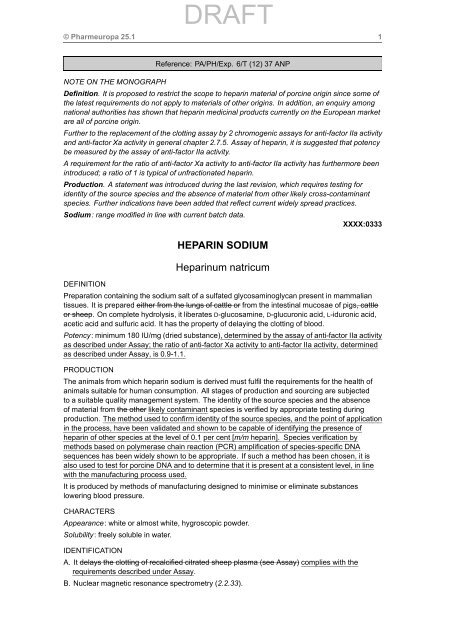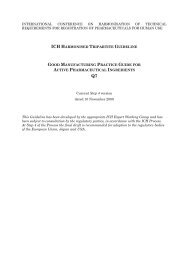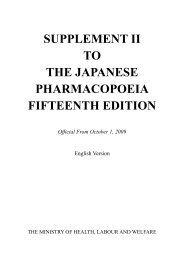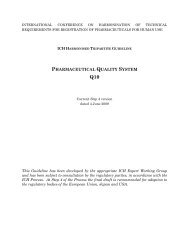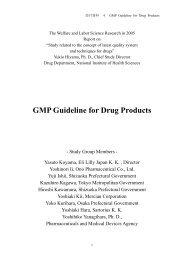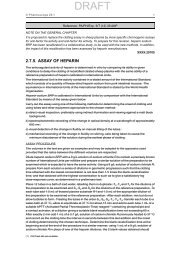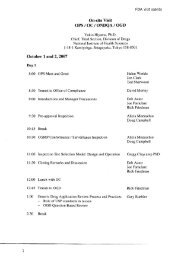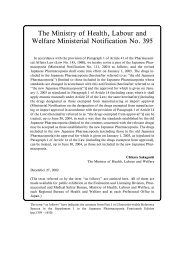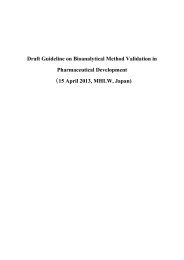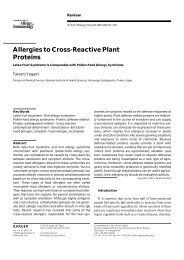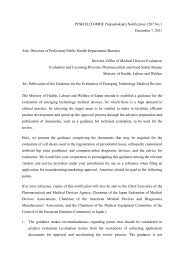HEPARIN SODIUM Heparinum natricum - NIHS
HEPARIN SODIUM Heparinum natricum - NIHS
HEPARIN SODIUM Heparinum natricum - NIHS
Create successful ePaper yourself
Turn your PDF publications into a flip-book with our unique Google optimized e-Paper software.
DRAFT<br />
© Pharmeuropa 25.1 1<br />
Reference: PA/PH/Exp. 6/T (12) 37 ANP<br />
NOTE ON THE MONOGRAPH<br />
Definition. It is proposed to restrict the scope to heparin material of porcine origin since some of<br />
the latest requirements do not apply to materials of other origins. In addition, an enquiry among<br />
national authorities has shown that heparin medicinal products currently on the European market<br />
are all of porcine origin.<br />
Further to the replacement of the clotting assay by 2 chromogenic assays for anti-factor IIa activity<br />
and anti-factor Xa activity in general chapter 2.7.5. Assay of heparin, it is suggested that potency<br />
be measured by the assay of anti-factor IIa activity.<br />
A requirement for the ratio of anti-factor Xa activity to anti-factor IIa activity has furthermore been<br />
introduced; a ratio of 1 is typical of unfractionated heparin.<br />
Production. A statement was introduced during the last revision, which requires testing for<br />
identity of the source species and the absence of material from other likely cross-contaminant<br />
species. Further indications have been added that reflect current widely spread practices.<br />
Sodium: range modified in line with current batch data.<br />
XXXX:0333<br />
<strong>HEPARIN</strong> <strong>SODIUM</strong><br />
<strong>Heparinum</strong> <strong>natricum</strong><br />
DEFINITION<br />
Preparation containing the sodium salt of a sulfated glycosaminoglycan present in mammalian<br />
tissues. It is prepared either from the lungs of cattle or from the intestinal mucosae of pigs, cattle<br />
or sheep. On complete hydrolysis, it liberates D-glucosamine, D-glucuronic acid, L-iduronic acid,<br />
acetic acid and sulfuric acid. It has the property of delaying the clotting of blood.<br />
Potency: minimum 180 IU/mg (dried substance), determined by the assay of anti-factor IIa activity<br />
as described under Assay; the ratio of anti-factor Xa activity to anti-factor IIa activity, determined<br />
as described under Assay, is 0.9-1.1.<br />
PRODUCTION<br />
The animals from which heparin sodium is derived must fulfil the requirements for the health of<br />
animals suitable for human consumption. All stages of production and sourcing are subjected<br />
to a suitable quality management system. The identity of the source species and the absence<br />
of material from the other likely contaminant speciesisverified by appropriate testing during<br />
production. The method used to confirm identity of the source species, and the point of application<br />
in the process, have been validated and shown to be capable of identifying the presence of<br />
heparin of other species at the level of 0.1 per cent [m/m heparin]. Species verification by<br />
methods based on polymerase chain reaction (PCR) amplification of species-specific DNA<br />
sequences has been widely shown to be appropriate. If such a method has been chosen, it is<br />
also used to test for porcine DNA and to determine that it is present at a consistent level, in line<br />
with the manufacturing process used.<br />
It is produced by methods of manufacturing designed to minimise or eliminate substances<br />
lowering blood pressure.<br />
CHARACTERS<br />
Appearance: white or almost white, hygroscopic powder.<br />
Solubility: freely soluble in water.<br />
IDENTIFICATION<br />
A. It delays the clotting of recalcified citrated sheep plasma (see Assay) complies with the<br />
requirements described under Assay.<br />
B. Nuclear magnetic resonance spectrometry (2.2.33).
DRAFT<br />
2 © Pharmeuropa 25.1<br />
Solution A. A solution in deuterium oxide R containing 20 µg/mL of deuterated sodium<br />
trimethylsilylpropionate R and if the signal at 5.22 ppm is smaller than 80 per cent of the signal<br />
at 5.44 ppm, 12 µg/mL of sodium edetate R.<br />
Preparation: dissolve20mgofthesubstancetobeexaminedin0.7mLofsolutionA.<br />
Comparison: dissolve20mgofheparin sodium for NMR identification CRS in 0.7 mL of<br />
solution A.<br />
If stored, the sodium edetate and deuterated sodium trimethylsilylpropionate solutions must be<br />
kept in high-density, natural polyethylene bottles.<br />
Apparatus: spectrometer operating at minimum 300 MHz.<br />
Acquisition of 1 H-NMR spectra:<br />
— number of transients: minimum 16; it is adjusted until the signal-to-noise ratio is at least<br />
1000:1 for the heparin methyl signal at 2.04 ppm;<br />
— temperature: about 25 °C; test sample and reference spectra have to be obtained at the<br />
same temperature;<br />
— acquisition time: minimum 2 s;<br />
— repetition time (acquisition time plus delay): minimum 4 s;<br />
— spectral width: 10-12 ppm, centred at around 4.5 ppm;<br />
— pulse width: togiveaflip angle between 30° and 90°.<br />
Processing:<br />
— exponential line-broadening window function: 0.3Hz;<br />
— Fourier transformation;<br />
— trimethylsilylpropionate reference signal set at 0.00 ppm.<br />
Results:<br />
— the large heparin sodium signals must be present: 2.04 ppm, 3.27 ppm (doublet), 4.34 ppm,<br />
5.22 ppm and 5.42 ppm, all within ± 0.03 ppm;<br />
— the 1 H-NMR spectrum obtained with the test sample and that obtained with heparin<br />
sodium for NMR identification CRS are compared qualitatively after the 2 spectra have<br />
been normalised so as to have a similar intensity; dermatan sulfate with a methyl signal at<br />
2.08 ± 0.02 ppm may be observed; no unidentified signals larger than 4 per cent compared<br />
to the height of the heparin signal at 5.42 ppm are present in the ranges 0.10-2.00 ppm,<br />
2.10-3.10 ppm and 5.70-8.00 ppm; signals from the solvent or process-related substances<br />
may be present and have to be identified to be accepted; variations in the intensity of<br />
some signal regions of the spectrum of heparin may occur: the intensity-variable regions<br />
are between 3.35 ppm and 4.55 ppm, where the signal pattern is approximately kept but<br />
intensity varies.<br />
C. Liquid chromatography (2.2.29) as described in the test for related substances with the<br />
following modifications.
DRAFT<br />
© Pharmeuropa 25.1 3<br />
The following chromatogram is shown for information but will not be published in the European<br />
Pharmacopoeia.<br />
1. dermatan sulfate + chondroitin<br />
sulfate<br />
2. heparin 3. over-sulfated chondroitin sulfate<br />
Figure 0333.-1. – Chromatogram for identification test C of heparin sodium: reference<br />
solution (c) (chromatogram obtained after subtraction of the blank)<br />
Injection: test solution (a) and reference solution (c).<br />
Relative retention with reference to heparin (retention time = about 26 min): dermatan sulfate<br />
and chondroitin sulfate = about 0.9; over-sulfated chondroitin sulfate = about 1.3.<br />
System suitability: reference solution (c):<br />
— peak-to-valley ratio: minimum 1.3, where H p<br />
= height above the baseline of the peak due to<br />
dermatan sulfate + chondroitin sulfate and H v<br />
= height above the baseline of the lowest point<br />
of the curve separating this peak from the peak due to heparin.<br />
Results: the principal peak in the chromatogram obtained with test solution (a) is similar in<br />
retention time and shape to the principal peak in the chromatogram obtained with reference<br />
solution (c).<br />
D. It complies with the test for sodium (see Tests).<br />
TESTS<br />
Appearance of solution. The solution is clear (2.2.1) and not more intensely coloured than<br />
intensity 5 of the range of reference solutions of the most appropriate colour (2.2.2, Method II).<br />
Dissolve a quantity equivalent to 50 000 IU in water R and dilute to 10 mL with the same solvent.<br />
pH (2.2.3):5.5to8.0.<br />
Dissolve 0.1 g in carbon dioxide-free water R and dilute to 10 mL with the same solvent.<br />
Nucleotidic impurities. Dissolve40mgin10mLofwater R. The absorbance (2.2.25)measured<br />
at 260 nm is not greater than 0.15.<br />
Protein: maximum 0.5 per cent (dried substance).<br />
Solution A. Mix 2 volumes of a 10 g/L solution of sodium hydroxide R and 2 volumes of a 50 g/L<br />
solution of sodium carbonate R and dilute to 5 volumes with water R.
DRAFT<br />
4 © Pharmeuropa 25.1<br />
Solution B. Mix 2 volumes of a 12.5 g/L solution of copper sulfate R and 2 volumes of a 29.8 g/L<br />
solution of sodium tartrate R and dilute to 5 volumes with water R.<br />
Solution C. Mix 1 volume of solution B and 50 volumes of solution A.<br />
Solution D. Dilute a phosphomolybdotungstic reagent (1) in water R. Suitable dilutions produce<br />
solutions of pH 10.25 ± 0.25 after addition of solutions C and D to the test and reference solutions.<br />
Test solution.Dissolvethesubstancetobeexaminedinwater R to obtain a concentration of<br />
5mg/mL.<br />
Reference solutions. Dissolve bovine albumin R1 in water R to obtain a concentration of<br />
100 mg/mL. Prepare dilutions of the solution in water R as prescribed in general chapter 2.5.33,<br />
method 2.<br />
Blank: water R.<br />
Procedure. To 1 mL of each reference solution, of the test solution and of the blank, add 5 mL of<br />
solution C. Allow to stand for 10 min. Add 0.5 mL of solution D, mix and allow to stand at room<br />
temperature for 30 min. Determine the absorbances (2.2.25) of the solutions at 750 nm, using<br />
the solution prepared from the blank as compensation liquid.<br />
Calculations. As prescribed in general chapter 2.5.33, method 2.<br />
Related substances. Liquid chromatography (2.2.29). Reference solutions are stable at room<br />
temperature for 24 h.<br />
The following chromatogram is shown for information but will not be published in the European<br />
Pharmacopoeia.<br />
1. dermatan sulfate + chondroitin sulfate 2. over-sulfated chondroitin sulfate<br />
Figure 0333.-2. – Chromatogram for the test for related substances of heparin sodium: reference<br />
solution (e) (chromatogram obtained after subtraction of the blank)<br />
Test solution (a). Dissolve an accurately weighed quantity of about 50 mg of the substance to be<br />
examined in 5.0 mL of water for chromatography R. Mix using a vortex mixer until dissolution is<br />
complete.<br />
(1) Folin-Ciocalteu’s phenol reagent from Merck (reference 1.09001.0500) is suitable.
DRAFT<br />
© Pharmeuropa 25.1 5<br />
Test solution (b). Dissolve an accurately weighed quantity of about 0.1 g of the substance to be<br />
examined in 1.0 mL of water for chromatography R. Mix using a vortex mixer until dissolution is<br />
complete. Mix 500 µL of the solution and 250 µL of 1 M hydrochloric acid, then add 50 µL of a<br />
250 mg/mL solution of sodium nitrite R (2) . Mix gently and allow to stand at room temperature for<br />
40 min before adding 200 µL of 1 M sodium hydroxide to stop the reaction.<br />
Reference solution (a). Dissolve 250 mg of heparin for physico-chemical analysis CRS in water<br />
for chromatography R and dilute to 2.0 mL with the same solvent. Mix using a vortex mixer until<br />
dissolution is complete.<br />
Reference solution (b). Add 1200 µL of reference solution (a) to 300 µL of dermatan sulfate and<br />
over-sulfated chondroitin sulfate CRS. Mix using a vortex mixer to homogenise.<br />
Reference solution (c). Add 100 µL of reference solution (b) to 900 µL of water for<br />
chromatography R. Mix using a vortex mixer to homogenise.<br />
Reference solution (d). Add 400 µL of reference solution (a) to 100 µL of water for<br />
chromatography R and mix using a vortex mixer. Add 250 µL of 1 M hydrochloric acid, then<br />
add50µLofa250mg/mLsolutionofsodium nitrite R. Mix gently and allow to stand at room<br />
temperature for 40 min before adding 200 µL of 1 M sodium hydroxide to stop the reaction.<br />
Reference solution (e). To 500 µL of reference solution (b), add 250 µL of 1 M hydrochloric acid,<br />
then add 50 µL of a 250 mg/mL solution of sodium nitrite R. Mix gently and allow to stand at room<br />
temperature for 40 min before adding 200 µL of 1 M sodium hydroxide to stop the reaction.<br />
Precolumn:<br />
— size: l =0.05m,Ø=2mm;<br />
— stationary phase: anion exchange resin R (13 µm) (3) .<br />
Column:<br />
— size: l =0.25m,Ø=2mm;<br />
— stationary phase: anion exchange resin R (9 µm) (4) ;<br />
— temperature: 40°C.<br />
Mobile phase:<br />
— mobile phase A: dissolve0.40gofsodium dihydrogen phosphate R in1Lofwater for<br />
chromatography R and adjust to pH 3.0 with dilute phosphoric acid R;<br />
— mobile phase B: dissolve0.40gofsodium dihydrogen phosphate R in1Lofwater for<br />
chromatography R, add 140 g of sodium perchlorate R (5) and adjust to pH 3.0 with dilute<br />
phosphoric acid R; filter and degas;<br />
Time<br />
Mobile phase A<br />
Mobile phase B<br />
(min)<br />
(per cent V/V)<br />
(per cent V/V)<br />
0-10 75 25<br />
10 - 35 75 → 0 25 → 100<br />
35 - 40 0 100<br />
Flow rate: 0.22 mL/min.<br />
Detection: spectrophotometer at 202 nm.<br />
Equilibration: at least 15 min.<br />
Injection: 20 µL of test solution (b) and reference solutions (d) and (e).<br />
Relative retention with reference to heparin (retention time = about 26 min): dermatan sulfate and<br />
chondroitin sulfate = about 0.9; over-sulfated chondroitin sulfate = about 1.3.<br />
System suitability:<br />
— the chromatogram obtained with reference solution (d) shows no peak at the retention time<br />
of heparin;<br />
(2) Sodium nitrite, analytical reagent grade from Fischer scientific (batch 0886083) is suitable.<br />
(3) AG11-HC from Dionex (reference 052963) is suitable.<br />
(4) AS11-HC from Dionex (reference 052961) is suitable.<br />
(5) Normapur from VWR/Prolabo (reference 27988.232) is suitable.
DRAFT<br />
6 © Pharmeuropa 25.1<br />
— resolution: minimum 3.0 between the peaks due to dermatan sulfate + chondroitin sulfate and<br />
over-sulfated chondroitin sulfate in the chromatogram obtained with reference solution (e).<br />
Limits:<br />
— sum of dermatan sulfate and chondroitin sulfate: not more than the area of the corresponding<br />
peak in the chromatogram obtained with reference solution (e) (2.0 per cent);<br />
— any other impurity: no peaks other than the peak due to dermatan sulfate + chondroitin<br />
sulfate are detected.<br />
Nitrogen (2.5.9): 1.5 per cent to 2.5 per cent (dried substance), determined on 0.100 g.<br />
Sodium: 9.5 per cent 10.5 per cent to 12.5 per cent 13.5 per cent (dried substance).<br />
Atomic absorption spectrometry (2.2.23, Method I).<br />
Test solution.Dissolve50mgofthesubstancetobeexaminedina1.27mg/mLsolutionof<br />
caesium chloride R in 0.1 M hydrochloric acid and dilute to 100.0 mL with the same solvent.<br />
Reference solutions. Prepare reference solutions containing 25 ppm, 50 ppm and 75 ppm of Na,<br />
using sodium standard solution (200 ppm Na) R diluted with a 1.27 mg/mL solution of caesium<br />
chloride R in 0.1 M hydrochloric acid.<br />
Source: sodium hollow-cathode lamp.<br />
Wavelength: 330.3 nm.<br />
Atomisation device: flame of suitable composition (for example 11 L of air and 2 L of acetylene<br />
per minute).<br />
Heavy metals (2.4.8): maximum 30 ppm.<br />
1.0 g complies with test F. Prepare the reference solution using 3.0 mL of lead standard solution<br />
(10 ppm Pb) R.<br />
Loss on drying (2.2.32): maximum 8.0 per cent, determined on 1.000 g by drying at 60 °C over<br />
diphosphorus pentoxide R at a pressure not exceeding 670 Pa for 3 h.<br />
Bacterial endotoxins (2.6.14): less than 0.01 IU per International Unit of heparin, if intended<br />
for use in the manufacture of parenteral preparations without a further appropriate procedure for<br />
the removal of bacterial endotoxins.<br />
ASSAY<br />
Carry out the assay of anti-factor IIa activity of heparin (2.7.5). The estimated potency is not less<br />
than 90 per cent and not more than 111 per cent of the stated potency. The confidence limits of<br />
the estimated potency (P = 0.95) are not less than 80 per cent and not more than 125 per cent<br />
of the stated potency.<br />
STORAGE<br />
In an airtight container. If the substance is sterile, store in a sterile, airtight, tamper-proof container.<br />
LABELLING<br />
The label states:<br />
— the number of International Units per milligram;<br />
— the animal species of origin;.<br />
— where applicable, that the substance is suitable for use in the manufacture of parenteral<br />
preparations.


